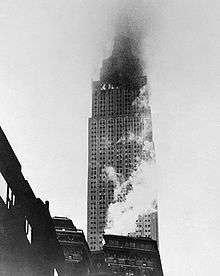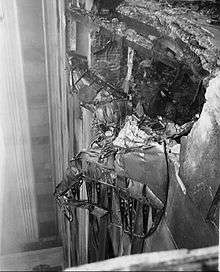B-25 Empire State Building crash
Coordinates: 40°44′54″N 73°59′08″W / 40.74833°N 73.98556°W
 The Building on fire following the crash by a U.S. Army B-25 bomber on July 28, 1945 | |
| Accident summary | |
|---|---|
| Date | July 28, 1945 |
| Summary | Controlled flight into terrain (building) |
| Site | Empire State Building, New York City |
| Crew | 3 |
| Fatalities | 14 (11 in building and 3 crew) |
| Aircraft type | B-25 Mitchell |
| Aircraft name | Old John Feather Merchant |
| Operator | U.S Army Air Forces |
| Registration | 41-30577 |
| Flight origin |
Bedford Army Air Field Bedford, Massachusetts |
The B-25 Empire State Building crash was a 1945 aircraft accident in which a B-25 Mitchell bomber, piloted in thick fog over New York City, crashed into the Empire State Building. The accident did not compromise the building's structural integrity, but it did cause fourteen deaths (three crewmen and eleven people in the building) and damage estimated at $1,000,000 ($13,166,359 in 2015 dollars).[1][2]
Details

On Saturday, July 28, 1945, William Franklin Smith, Jr., was piloting a B-25 Mitchell bomber on a routine personnel transport mission from Bedford Army Air Field to Newark Airport.[3][4][5] Smith asked for clearance to land, but was advised of zero visibility.[6] Proceeding anyway, he became disoriented by the fog, and started turning right instead of left after passing the Chrysler Building.[7]
At 9:40 a.m., the aircraft crashed into the north side of the Empire State Building, between the 78th and 80th floors, carving an 18-by-20-foot (5.5 m × 6.1 m) hole in the building[8] where the offices of the National Catholic Welfare Council were located. One engine shot through the South side opposite the impact and flew as far as the next block, dropping 900 feet and landing on the roof of a nearby building and starting a fire that destroyed a penthouse art studio. The other engine and part of the landing gear plummeted down an elevator shaft. The resulting fire was extinguished in 40 minutes. It is still the only fire at such a height to be brought under control.[8]
Fourteen people were killed: Smith, the two others aboard the bomber (Staff Sergeant Christopher Domitrovich and Albert Perna, a Navy aviation machinist's friend hitching a ride), and eleven others in the building.[2] Smith was not found until two days later after search crews found that his body had gone through an elevator shaft and fallen to the bottom.[9] Elevator operator Betty Lou Oliver was injured. Rescuers decided to transport her on an elevator that they did not know had weakened cables. The cables snapped and the elevator fell 75 stories, ending up in the basements. She managed to survive the fall, which still stands as the Guinness World Record for the longest survived elevator fall, and was later found by rescue workers among the rubble.[7]
Despite the damage and loss of life, the building was open for business on many floors on the following Monday. The crash spurred the passage of the long-pending Federal Tort Claims Act of 1946, as well as the insertion of retroactive provisions into the law, allowing people to sue the government for the accident.[10]
A missing stone in the facade served as evidence of where the aircraft crashed into the building.
In the 1960s, when the World Trade Center was being designed, this B-25 impact incident served as motivation for the designers to consider a scenario of an accidental impact of a Boeing 707 into one of the twin towers. The towers were destroyed when two Boeing 767s were intentionally flown into them during the September 11 attacks of 2001.
See also
- 1946 40 Wall Street Plane crash
- 2001 September 11 attacks
- 2002 Tampa airplane crash
- 2002 Pirelli Tower airplane crash
- 2006 New York City plane crash
- 2010 Austin suicide attack
- 2014 Wichita King Air crash
- Skyscraper fire
References
- ↑ Jennifer Rosenberg. "The Plane That Crashed Into the Empire State Building". about.com.
- 1 2 "Empire State Building Withstood Airplane Impact". JOM (monthly publication of The Minerals, Metals & Materials Society). 2001.
- ↑ Berman, John S. (2003). The Empire State Building: The Museum of the City of New York. Barnes,John & Noble Publishing.
- ↑ Barron, James (July 28, 1995). "Flaming Horror on the 79th Floor; 50 Years Ago Today, in the Fog, a Plane Hit the World's Tallest Building". The New York Times. Retrieved November 17, 2012.
- ↑ Byers, Roland O. (1985). Flak dodger: a story of the 457th Bombardment Group, 1943-1945, 8th AAF. Pawpaw Press.
- ↑ Joe Richman (July 28, 2008). "The Day A Bomber Hit The Empire State Building". NPR.
- 1 2 "Longest Fall Survived In An Elevator". guinnessworldrecords.com. Archived from the original on March 17, 2006.
- 1 2 Molnar, Matt. "On This Day in Aviation History: July 28th". NYCAviation. Retrieved 2009-07-28.
- ↑ "B-25 Empire State Building Collision". Aerospaceweb.org. Retrieved April 8, 2012.
- ↑ Joe Richman (July 28, 2008). "The Day A Bomber Hit The Empire State Building". NPR. Retrieved July 28, 2008.
Eight months after the crash, the U.S. government offered money to families of the victims. Some accepted, but others initiated a lawsuit that resulted in landmark legislation. The Federal Tort Claims Act of 1946, for the first time, gave American citizens the right to sue the federal government.
External links
- On This Day in Aviation History: July 28th – NYCAviation
- Plane Hits Empire State Building
- Bomber Crash into Empire State Building, engineering case study calculating the impact force of the bomber (Archived from the original on 2004-07-15. Retrieved 2016-06-26.)
- The short film Stillman Fires Collection: Empire State Building is available for free download at the Internet Archive
- Empire State Crash Video produced by the PBS Series History Detectives